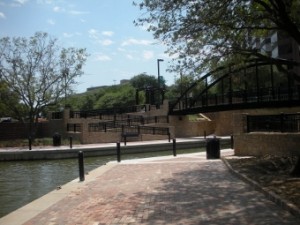The first in this series.
A couple of years ago during spring, I traveled to the Lone Star State from California. Destination: Grand Prairie, Texas.
Having only been to Texas on one previous occasion traveling through the Texas panhandle region, my visit to Grand Prairie was memorable and for reasons which should become clear.
Right off the bat some people reading this may think I’m a little confused by my picking Grand Prairie to profile for what is supposed to be a “Great Western Cities” tour. Well, figure it this way: If you look at a U.S. map and if the map were to be folded in equal halves longitudinally, where does Grand Prairie lie: On the eastern or western half? On the map I have, the Texas town lands in the western half, but just barely. Ergo, satisfying my criteria for being an “out west” city.
So, when on a road trip what I pay particularly close attention to is: traffic or in getting around, the ease or difficulty with which to do that; available public transportation choices; housing type; area attractions; and, of course, the quality of the air.
As far as big cities go Grand Prairie is a conurbation in a cluster of cities and is flanked by Dallas on the east and Ft. Worth on the west. In fact, in driving through Irving one day just to the north and in my quest to pay a visit to Las Colinas, I happened upon a location where the Dallas skyline came into full view. That was one of the trip highlights.
Now, as to why I was on my way to Las Colinas, this is for reasons not too difficult to imagine.
For those not in the know, Las Colinas is unique. And that is understating things a bit. Built in 1972, the community has to be one of the earliest examples of a planned, mixed-use, transit-oriented development or TOD in the U.S.
What caught my eye is how compact and architecturally and aesthetically appealing the community is. Another of Las Colinas’ most distinguishing features is Lake Carolyn and the lake is the centerpiece, the community focal point, if you like, the city proper built up around it.

Another of the area’s more distinguishing characteristics is the built-up environment; many multi-story residential dwellings, hotels and office complexes. There is also ground-floor retail and dining venues galore, it seems. In fact, Las Colinas is pleasant, quiet, very pedestrian friendly (walkable) and quite easy-going as far as communities are concerned. Moreover, Las Colinas is punctuated by both its very own Area Personal Transit (APT) people mover system and the regional Dallas Area Rapid Transit (DART) light rail service. Nothing seems lacking – and I mean nothing.
Continuing with transportation and more globally, Grand Prairie sits in a sea of freeways and toll-ways. But in that dizzying maze one can still find solace and take comfort in knowing that the region is not for want of light and heavy commuter rail, which, in the region, is quite extensive.
First, there is DART (mentioned above) and it now goes all the way to DFW (Dallas-Ft. Worth) International Airport. Bolstered by this service is the Trinity Railway Express heavy rail commuter system. Transit buses were plentiful too.
On the attractions front, these abound. If you can name it you can probably find it – sports- and country-themed venues in particular.
On my May visit air quality was good to moderate and there was a considerable amount of rain during my stay. But, it was also muggy.
In my opinion, if the residential element wasn’t so sprawled out and more people took advantage of the region’s relatively vast array of mass transit, I truly believe that not only would there be a lot less congestion and gridlock plaguing local highways, but air would be considerably cleaner.
Even if not resembling a prairie, Grand Prairie is “grand” nevertheless.
– Alan Kandel